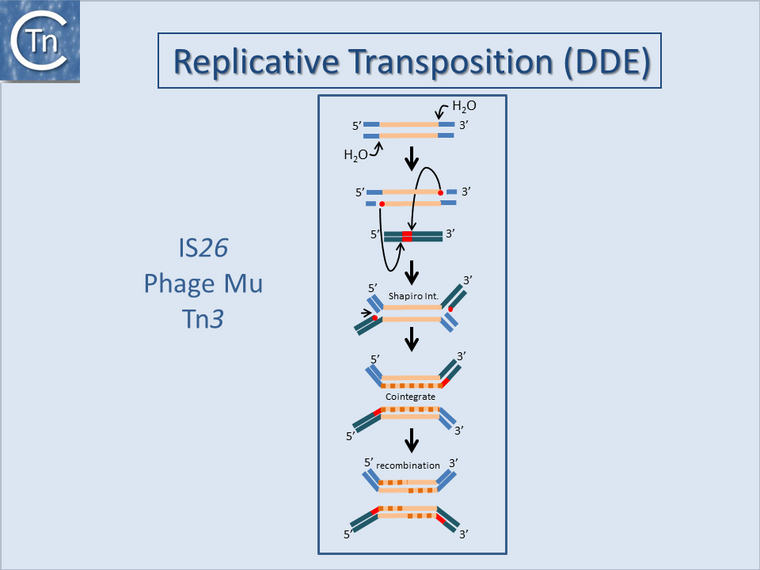The way in which strand cleavages and transfers occur during transposition also affects the outcome of the transposition events and therefore impinges on genome structure. For IS with DDE Tpases, Tn3 and IS6 family members generate fusions or cointegrates between the donor and target replicons by a process of replicative transposition, presumably by Target Primed Replicative Transposition (TPRT)[1][2][3] (Fig.17.1 and Fig.17.2 top).
However, in the event of intramolecular transposition, this type of mechanism is expected to give rise to inversions with a copy of the IS at each junction or inversions with a single IS copy remaining and a second copy segregating with a circularized deletion[4] (Fig.17.2 botton; see [5]). Note that similar effects are also known to occur by homologous recombination between two inverted or directly repeated IS copies in a replicon. Other known mechanisms such as cut-and-paste, or copy-and-paste (Donor Primed Replicatice Transposition; DPRT)[6] would not generate this type of genomic rearrangement but could contribute to genomic modifications in other ways such as “nearly precise excision”[7] or by using alternative sequences which resemble their IR[8][9].

Fig.17.1. Replicative Transposition (DDE) of TE such as
Tn3 and bacteriophage Mu. The figure shows the transposition mechanism of replicative TE that uses a DDE Tpase. The transposon is represented as a yellow line. Flanking sequences in the donor molecule is blue. Flanking sequences in the target molecule are green. Red circles indicate 3′OH moieties generated by Tpase-catalyzed hydrolysis at the transposon end(s). Red boxes indicate target DNA flanks that are duplicated on insertion.
Top to bottom: Tpase catalyzed cleavage at the 3′ transposon ends using H2O as the nucleophile. Liberated 3′OH attack the target in a staggered manner to create a branched molecule in which the transposon bridges both donor and target molecules. Replication proceeds, probably using the 3′OH liberated in the flanking target DNA, to generate a second transposon copy (newly replicated DNA is shown as a dotted orange line). If the donor and target DNA are circular molecules, this fuses the two, resulting in a cointegrate where the donor and target DNA are joined at each junction by a TE copy. [Not shown Recombination between the two directly repeated TE ‘resolves’ the cointegrate into the original donor molecule and a target that now contains a copy of the TE. Recombination may use the host homologous recombination system but in the case of the
Tn3 family, TnpR, one of several alternative site-specific recombinases, promotes recombination at a specific DNA sequence, the res site.]

Fig.17.1. Replicative Transposition (DDE) of TE such as
Tn3 and bacteriophage Mu. The figure shows the transposition mechanism of replicative TE that uses a DDE Tpase. The transposon is represented as a yellow line. Flanking sequences in the donor molecule is blue. Flanking sequences in the target molecule are green. Red circles indicate 3′OH moieties generated by Tpase-catalyzed hydrolysis at the transposon end(s). Red boxes indicate target DNA flanks that are duplicated on insertion.
Top to bottom: Tpase catalyzed cleavage at the 3′ transposon ends using H2O as the nucleophile. Liberated 3′OH attack the target in a staggered manner to create a branched molecule in which the transposon bridges both donor and target molecules. Replication proceeds, probably using the 3′OH liberated in the flanking target DNA, to generate a second transposon copy (newly replicated DNA is shown as a dotted orange line). If the donor and target DNA are circular molecules, this fuses the two, resulting in a cointegrate where the donor and target DNA are joined at each junction by a TE copy. [
Not shown Recombination between the two directly repeated TE ‘resolves’ the cointegrate into the original donor molecule and a target that now contains a copy of the TE. Recombination may use the host homologous recombination system but in the case of the Tn3 family, TnpR, one of several alternative site-specific recombinases, promotes recombination at a specific DNA sequence, the res site.]
Bibliography
- ↑
Hickman AB, Chandler M, Dyda F . Integrating prokaryotes and eukaryotes: DNA transposases in light of structure. - Crit Rev Biochem Mol Biol: 2010 Feb, 45(1);50-69 [PubMed:20067338]
[DOI]
- ↑
- ↑
- ↑
Shapiro JA . Molecular model for the transposition and replication of bacteriophage Mu and other transposable elements. - Proc Natl Acad Sci U S A: 1979 Apr, 76(4);1933-7 [PubMed:287033]
[DOI]
- ↑
- ↑
- ↑
Ross DG, Swan J, Kleckner N . Nearly precise excision: a new type of DNA alteration associated with the translocatable element Tn10. - Cell: 1979 Apr, 16(4);733-8 [PubMed:455447]
[DOI]
- ↑
- ↑

